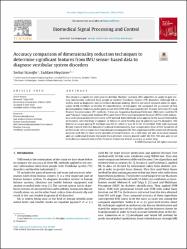Accuracy comparison of dimensionality reduction techniques to determine significant features from IMU sensor-based data to diagnose vestibular system disorders
Abstract
This study is a significant step gone to develop Machine Learning (ML) algorithm to apply to gait sensory information collected from people to identify Vestibular System (VS) disorders. Although ML is widely used as diagnostic tool in medical decision-making, there is not much research done on application of ML methods to identify VS imperfections. In this paper, we compared the accuracies of two dimensionality-reduction techniques to use with SVM with Gaussian Kernel: Feature Selection (FS) and Feature Transformation (FT) methods. T-test and Sequential Backward Selection (SBS) were used for FS and Principal Component Analysis (PCA) and Kernel Principal Component Analysis (KPCA) with polynomial and Gaussian kernels were used as FT method. Both methods were applied to the dataset formed by 22 features collected from 37 people, of whom 21 were healthy and 16 subjects had VS-disorders. The highest accuracy among FT methods was 89.2%, while it was 81.1% for FS method. SVM with Gaussian Kernel, trained with the dataset of reduced dimensionality, had computation time of few hundreds of milliseconds, which makes real-time data processing possible. The importance of this work will obviously increase with the increase in the number of initial features. As a next step, we aim to increase dataset and use additional features extracted from pressure sensors placed under the feet. We also aim to use time domain characteristics of the features to increase overall accuracy as a next step.
Volume
61Collections
The following license files are associated with this item:


















